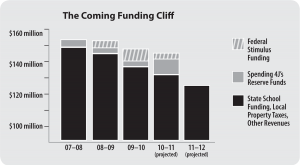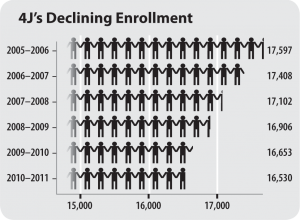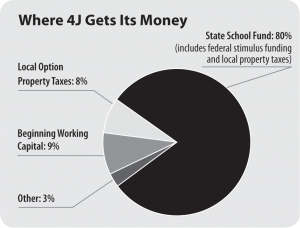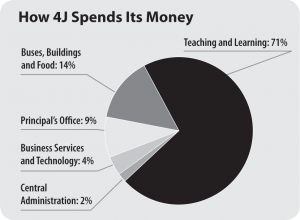 How do we provide 21st century learning and support achievement for all students in these tough economic times?
How do we provide 21st century learning and support achievement for all students in these tough economic times?
What are we facing?
• Widening gap: The district’s financial challenges have been growing each year due to increasing expenses and decreasing revenues.
• Funding cliff: Even after making deep cuts in recent school years, 4J faces a projected deficit next year of about $22–28 million — that’s a staggering 15–20% of the district’s operating budget.
 Where did this shortfall come from?
Where did this shortfall come from?
• Less funding per student: State funding, local option property taxes, and other revenue sources have dropped due to the poor economy.
• Fewer students: 4J’s enrollment has been declining for many years. Today, we have about 1,050 fewer students than just five years ago. Fewer students means less revenue from the state.
• Use of one-time funds: The district has been spending reserves and federal stimulus dollars to support operations. Like a family spending their savings to cover monthly household expenses, this helps make ends meet in the short term, but it isn’t sustainable.
• Rising costs: Increases include salary and benefit costs, utilities and materials.
 What have we done so far?
What have we done so far?
4J has made substantial budget reductions in recent years. The district has cut school days, school staff, central office staff and services, employee compensation agreements, materials and supplies budgets, funding for athletics and extracurricular activities, and more.
Most of 4J’s budget is invested directly in classrooms and schools — roughly 94% of our budget pays for school staff, buses and buildings — so it has not been possible to keep reductions away from the classroom entirely.
 What comes next?
What comes next?
The Eugene School Board is working to develop a sustainable budget. Their goal is a multi-year plan that will bring services in line with revenue, put 4J on a sustainable course, and continue to provide all kids with a sound education.
We’re also thinking about how we can redesign instruction, not just reduce services. We will consider changes in the way we use our resources, deliver services, and staff our schools and central services.
Our staff, students, parents and community will be affected by the changes ahead and will be part of the conversation moving forward.